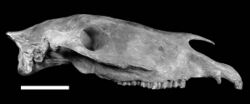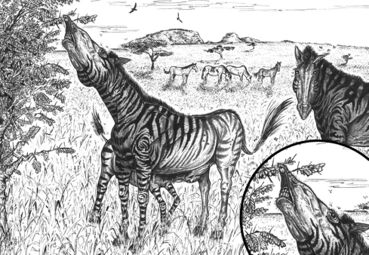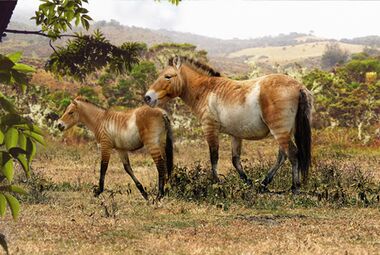Biology:Amerhippus
| Amerhippus | |
|---|---|

| |
| Skull of Amerhippus sp. | |
| Scientific classification | |
| Script error: No such module "Taxobox ranks".: | Animalia |
| Script error: No such module "Taxobox ranks".: | Chordata |
| Script error: No such module "Taxobox ranks".: | Mammalia |
| Script error: No such module "Taxobox ranks".: | Perissodactyla |
| Script error: No such module "Taxobox ranks".: | Equidae |
| Script error: No such module "Taxobox ranks".: | Equus |
| Script error: No such module "Taxobox ranks".: | †Amerhippus Hoffstetter, 1950 |
| Type species | |
| †Equus andium Branco, 1883
| |
| Species | |
| |
Amerhippus is an extinct South American horse of uncertain taxonomic identity. It is sometimes classified as a subgenus of the genus Equus, containing several extinct species of horses that lived in South America, or a single, morphologically variable extinct species, Equus neogeus.
Description
It lived from 2.588 to 0.012 Mya. It measured roughly 1.5 m (4.9 ft) tall and weighed approximately 400 kg (880 lb).[2]
Distribution
They were one of two groups of equines in South America, alongside Hippidion.[3] Fossils have been recovered from the Tarija Formation of Bolivia, the Serranía del Perijá in Venezuela, the Chiu-Chiu Formation of Chile , the Sabana Formation of the Bogotá savanna in Colombia,[4] and from various locations in Ecuador.[2]
Ecology
A 2019 study suggested that Equus neogeus was primarily a grazer that fed on both C4 and C3 grasses in prairies and open woodlands.[5]
Taxonomy
While they have formerly been referred to as belonging to 5 separate species, this has been revised down into three,[6] and more recently a single, morphologically variable species Equus neogeus.[7][8] Equus first appeared in South America during the late Early Pleistocene around 1 Ma.[3] A 2008 study of mitochondrial DNA fragments of a specimen of E. neogeus found it to be nested within mitochondrial lineages of E. caballus,[9] however, later studies suggested that this result required more specimens to be analysed for confirmation.[10] A close relationship to caballine horses was also supported by a 2019 morphological analysis study.[11]
Gallery
-
Statue in Osorno, Chile
-
Restoration of hippidiforms with grazing Amerhippus in the background
-
Photo-reconstruction of Equus (Amerhippus) andium from paleoartist Roman Uchytel
References
- ↑ "Amerhippus" (in en). Bethesda, MD: National Center for Biotechnology Information. https://www.ncbi.nlm.nih.gov/Taxonomy/Browser/wwwtax.cgi?mode=Tree&id=35507&lvl=3&keep=1&srchmode=1&unlock.
- ↑ 2.0 2.1 Prado, J. L.; Alberdi, M. A. T.; De Reyes, M. N. L.; Poiré, D. G.; Canalicchio, J. M. (2013). "New material of Equus (Amerhippus) neogeus (Mammalia, Perissodactyla) from the late Pleistocene of Olavarría (Argentina)". Neues Jahrbuch für Geologie und Paläontologie - Abhandlungen 269 (2): 125. doi:10.1127/0077-7749/2013/0340.
- ↑ 3.0 3.1 PRADO, JOSE LUIS; ALBERDI, MARIA TERESA (2018). FOSSIL HORSES OF SOUTH AMERICA : phylogeny, systemics and ecology.. SPRINGER INTERNATIONAL PU. doi:10.1007/978-3-319-55877-6. ISBN 978-3-319-85769-5. OCLC 1048948248. http://worldcat.org/oclc/1048948248.
- ↑ De Porta, Jaime. 1960. Los Equidos fósiles de la Sabana de Bogotá. Boletín de Geología, Universidad Industrial de Santander 4. 51–78. Accessed 2017-03-30.
- ↑ Morosi, Elizabeth; Ubilla, Martin (December 2019). "Feeding and environmental studies on late Pleistocene horses in mid-latitudes of South America (northern Uruguay)" (in en). Quaternary Science Reviews 225: 106025. doi:10.1016/j.quascirev.2019.106025. https://linkinghub.elsevier.com/retrieve/pii/S0277379119305384.
- ↑ Prado, J. L., and Alberdi, M. T. (2017). Fossil Horses of South America. Springer International Publishing, 150
- ↑ Machado, Helena; Grillo, Orlando; Scott, Eric; Avilla, Leonardo (September 2018). "Following the Footsteps of the South American Equus: Are Autopodia Taxonomically Informative?" (in en). Journal of Mammalian Evolution 25 (3): 397–405. doi:10.1007/s10914-017-9389-6. ISSN 1064-7554. http://link.springer.com/10.1007/s10914-017-9389-6.
- ↑ Machado, Helena; Avilla, Leonardo (2019-07-03). "The Diversity of South American Equus: Did Size Really Matter?". Frontiers in Ecology and Evolution 7: 235. doi:10.3389/fevo.2019.00235. ISSN 2296-701X.
- ↑ Orlando, Ludovic; Male, Dean; Alberdi, Maria Teresa; Prado, Jose Luis; Prieto, Alfredo; Cooper, Alan; Hänni, Catherine (May 2008). "Ancient DNA Clarifies the Evolutionary History of American Late Pleistocene Equids" (in en). Journal of Molecular Evolution 66 (5): 533–538. doi:10.1007/s00239-008-9100-x. ISSN 0022-2844. PMID 18398561. Bibcode: 2008JMolE..66..533O. http://link.springer.com/10.1007/s00239-008-9100-x.
- ↑ Barrón-Ortiz, Christina I.; Rodrigues, Antonia T.; Theodor, Jessica M.; Kooyman, Brian P.; Yang, Dongya Y.; Speller, Camilla F. (2017-08-17). Orlando, Ludovic. ed. "Cheek tooth morphology and ancient mitochondrial DNA of late Pleistocene horses from the western interior of North America: Implications for the taxonomy of North American Late Pleistocene Equus" (in en). PLOS ONE 12 (8): e0183045. doi:10.1371/journal.pone.0183045. ISSN 1932-6203. PMID 28817644.
- ↑ Barrón-Ortiz, Christina I.; Avilla, Leonardo S.; Jass, Christopher N.; Bravo-Cuevas, Víctor M.; Machado, Helena; Mothé, Dimila (2019-09-12). "What Is Equus? Reconciling Taxonomy and Phylogenetic Analyses". Frontiers in Ecology and Evolution 7: 343. doi:10.3389/fevo.2019.00343. ISSN 2296-701X.
Wikidata ☰ Q5672399 entry



